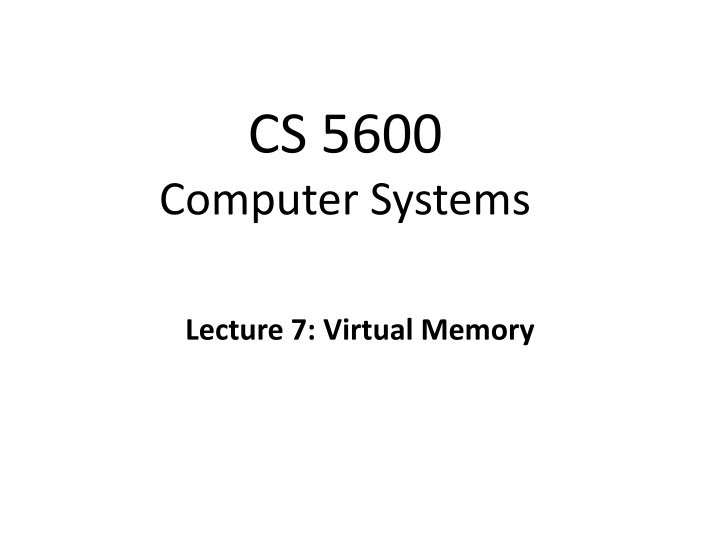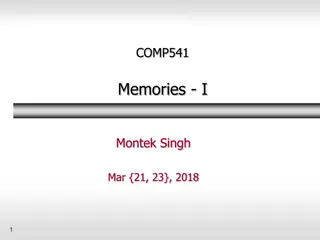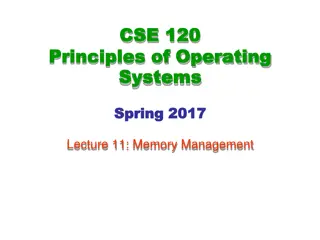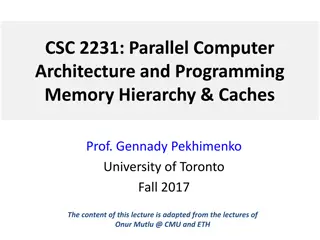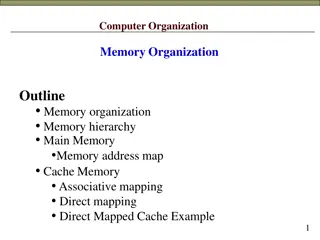Overview of Virtual Memory in Computer Systems
Main memory in computer systems is conceptually simple, but memory management is one of the most complex features in modern operating systems. This complexity arises due to the need for protection, isolation, and efficient handling of memory resources. Virtual memory addresses these challenges by providing a layer of abstraction that allows processes to use logical addresses translated to physical addresses. The limited size, lack of protection, fixed pointer addresses, and other constraints of physical memory are overcome through virtualization, enabling various advanced features.
Download Presentation

Please find below an Image/Link to download the presentation.
The content on the website is provided AS IS for your information and personal use only. It may not be sold, licensed, or shared on other websites without obtaining consent from the author.If you encounter any issues during the download, it is possible that the publisher has removed the file from their server.
You are allowed to download the files provided on this website for personal or commercial use, subject to the condition that they are used lawfully. All files are the property of their respective owners.
The content on the website is provided AS IS for your information and personal use only. It may not be sold, licensed, or shared on other websites without obtaining consent from the author.
E N D
Presentation Transcript
CS 5600 Computer Systems Lecture 7: Virtual Memory
Motivation and Goals Base and Bounds Segmentation Page Tables TLB Multi-level Page Tables Swap Space 2
Main Memory Main memory is conceptually very simple Code sits in memory Data is either on a stack or a heap Everything gets accessed via pointers Data can be written to or read from long term storage Memory is a simple and obvious device So why is memory management one of the most complex features in modern OSes? 3
Protection and Isolation Physical Memory Physical memory does not offer protection or isolation 0xFFFFFFFF Kernel Memory Process 1 w/ Secret Data Oh sorry, I didn t mean to overwrite your task_structs ;) Evil Process I m in your process, stealing your data ;) 0x00000000 4
Compilation and Program Loading Physical Memory 0xFFFFFFFF Compiled programs include fixed pointer addresses Example: 000FE4D8 <foo>: 000FE21A: push eax 000FE21D: push ebx 000FE21F: call 0x000FE4D8 Problem: what if the program is not loaded at corresponding address? Kernel Memory Addr of foo(): 0x0DEB49A3 Process 2 Addr of foo(): 0x000FE4D8 Process 1 0x00000000 5
Physical Memory has Limited Size 0xFFFFFFFF RAM is cheap, but not as cheap as solid state or cloud storage What happens when you run out of RAM? Kernel Memory Process 4 Process 5 Process 3 Process 2 Process 1 0x00000000 6
Physical vs. Virtual Memory Clearly, physical memory has limitations No protection or isolation Fixed pointer addresses Limited size Etc. Virtualization can solve these problems! As well as enable additional, cool features 7
A Toy Example What do we mean by virtual memory? Processes use virtual (or logical) addresses Virtual addresses are translated to physical addresses Physical Memory (Reality) Process View of Virtual Memory Magical Address Translation Black Box 0xFFFF 0xFFFF Kernel Memory All the memory belongs to me! Process 3 Physical Address Process 1 I am master of all I survey! Virtual Address Process 2 Process 1 0x0000 0x0000
Implementing Address Translation In a system with virtual memory, each memory access must be translated Can the OS perform address translation? Only if programs are interpreted Modern systems have hardware support that facilitates address translation Implemented in the Memory Management Unit (MMU) of the CPU Cooperates with the OS to translate virtual addresses into physical addresses 9
Virtual Memory Implementations There are many ways to implement an MMU Base and bound registers Segmentation Page tables Multi-level page tables Old, simple, limited functionality Modern, complex, lots of functionality We will discuss each of these approaches How does it work? What features does it offer? What are the limitations? 10
Goals of Virtual Memory Transparency Processes are unaware of virtualization Protection and isolation Flexible memory placement OS should be able to move things around in memory Shared memory and memory mapped files Efficient interprocess communication Shared code segments, i.e. dynamic libraries Dynamic memory allocation Grow heaps and stacks on demand, no need to pre-allocate large blocks of empty memory Support for sparse address spaces Demand-based paging Create the illusion of near-infinite memory 11
Motivation and Goals Base and Bounds Segmentation Page Tables TLB Multi-level Page Tables Swap Space 12
Base and Bounds Registers A simple mechanism for address translation Maps a contiguous virtual address region to a contiguous physical address region Physical Memory Process View of Virtual Memory 0xFFFF Kernel Memory 0x1001 Process 1 0x10FF Register Value 0x0001 Process 1 EIP 0x0023 ESP 0x0F76 0x00FF BASE 0x00FF 0x0000 BOUND 0x1000 13
Base and Bounds Example 0x0023 mov eax, [esp] Physical Memory Process View of Virtual Memory 0xFFFF Kernel Memory 0x1001 1) Fetch instruction 0x0023 + 0x00FF = 0x0122 2 Process 1 0x10FF 1 2 0x0001 2) Translate memory access 0x0F76 + 0x00FF = 0x1075 Process 1 1 Register Value 0x00FF EIP 0x0023 0x0000 ESP 0x0F76 3) Move value to register [0x1075] eax BASE 0x00FF BOUND 0x1000 14
Protection and Isolation 0x0023 mov eax, [0x4234] Physical Memory Process View of Virtual Memory 0xFFFF Kernel Memory 1) Fetch instruction 0x0023 + 0x00FF = 0x0122 2 2 0x1001 0x10FF Process 1 2) Translate memory access 0x4234 + 0x00FF = 0x4333 0x1333 > 0x10FF (BASE + BOUND) Raise Protection Exception! Process 1 1 1 0x0001 0x00FF 0x0000 Register Value EIP 0x0023 ESP 0x0F76 BASE 0x00FF BOUND 0x1000 15
Implementation Details BASE and BOUND are protected registers Only code in Ring 0 may modify BASE and BOUND Prevents processes from modifying their own sandbox Each CPU has one BASE and one BOUND register Just like ESP, EIP, EAX, etc Thus, BASE and BOUND must be saved a restored during context switching 16
Base and Bound Pseudocode 1. PhysAddr = VirtualAddress + BASE 2. if (PhysAddr >= BASE + BOUND) 3. RaiseException(PROTECTION_FAULT) 4. Register = AccessMemory(PhysAddr) 17
Advantages of Base and Bound Physical Memory 0xFFFFFFFF Kernel Memory Simple hardware implementation Simple to manage each process virtual space Processes can be loaded at arbitrary fixed addresses Offers protection and isolation Offers flexible placement of data in memory No, I m loaded at address 0x00AF Process 2 Previous BASE 0x00FF New BASE 0x10A0 I m loaded at address 0x00AF Process 1 0x00000000 18
Limitations of Base and Bound Physical Memory Processes can overwrite their own code Processes aren t protected from themselves No sharing of memory Code (read-only) is mixed in with data (read/write) Process memory cannot grow dynamically May lead to internal fragmentation 0xFFFFFFFF Kernel Memory /bin/bash Data Code /bin/bash Data Code is duplicated in memory :( Code 0x00000000 19
Internal Fragmentation BOUND determines the max amount of memory available to a process How much memory do we allocate? Empty space leads to internal fragmentation What if we don t allocate enough? Increasing BOUND after the process is running doesn t help Physical Memory Wasted space = internal fragmentation doesn t move the stack away from the heap Increasing BOUND Stack Stack Heap Heap Code 20
Motivation and Goals Base and Bounds Segmentation Page Tables TLB Multi-level Page Tables Swap Space 21
Towards Segmented Memory Having a single BASE and a single BOUND means code, stack, and heap are all in one memory region Leads to internal fragmentation Prevents dynamically growing the stack and heap Segmentation is a generalization of the base and bounds approach Give each process several pairs of base/bounds May or may not be stored in dedicated registers Each pair defines a segment Each segment can be moved or resized independently 22
Segmentation Details The code and data of a process get split into several segments 3 segments is common: code, heap, and stack Some architectures support >3 segments per process Each process views its segments as a contiguous region of memory But in physical memory, the segments can be placed in arbitrary locations Question: given a virtual address, how does the CPU determine which segment is being addressed? 23
Segments and Offsets Key idea: split virtual addresses into a segment index and an offset Example: suppose we have 14-bit addresses Top 2 bits are the segment Bottom 12 bits are the offset 13 12 11 10 9 8 7 6 5 4 3 2 1 0 Segment Offset 4 possible segments per process 00, 01, 10, 11 24
Separation of Responsibility The OS manages segments and their indexes Creates segments for new processes in free physical memory Builds a table mapping segments indexes to base addresses and bounds Swaps out the tables and segment registers during context switches Frees segments from physical memory The CPU translates virtual addresses to physical addresses on demand Uses the segment registers/segment tables built by the OS 25
Segmentation Example 0x0023 mov eax, [esp] 1) Fetch instruction 0x0023 (EIP) - 00000000100011 Process View of Virtual Memory Physical Memory 0xFFFF Kernel Memory 0x3FFF 0xB100 0xB000 Heap 0x0020 (CS) + 0x0023 = 0x0043 2) Translate memory access 0x2015 (ESP) 10000000010101 0x3000 Code Stack Stack 0x2000 0x0400 (SS) + 0x0015 = 0x0415 Heap Heap 0x0500 Stack 0x1000 0x0400 Segment Index Base Bound 0x0120 Code CS (Code) 00 0x0020 0x0100 0x0020 Code 0x0000 0x0000 HS (Heap) 01 0xB000 0x0100 SS (Stack) 10 0x0400 0x0100 26
Segmentation Pseudocode 1. // get top 2 bits of 14-bit VA 2. Segment = (VirtualAddress & SEG_MASK) >> SEG_SHIFT 3. // now get offset 4. Offset = VirtualAddress & OFFSET_MASK 5. if (Offset >= Bounds[Segment]) 6. RaiseException(PROTECTION_FAULT) 7. else 8. PhysAddr = Base[Segment] + Offset 9. Register = AccessMemory(PhysAddr) 27
More on Segments In the previous example, we use a 14-bit address space with 2 bits reserved for the segment index This limits us to 4 segments per process Each segment is 212 = 4KB in size Real segmentation systems tend to have 1. More bits for the segments index (16-bits for x86) 2. More bits for the offset (16-bits for x86) However, segments are course-grained Limited number of segments per process (typically ~4) 28
Segment Permissions Many CPUs (including x86) support permissions on segments Read, write, and executable Disallowed operations trigger an exception E.g. Trying to write to the code segment Process 1 s View of Virtual Memory 0x3FFF .rodata 0x3000 Stack 0x2000 Heap Index Base Bound Permissions 0x1000 00 0x0020 0x0100 RX 01 0xB000 0x0100 RW Code 10 0x0400 0x0100 RW 0x0000 11 0xE500 0x100 R 29
x86 Segments Intel 80286 introduced segmented memory CS code segment register SS stack segment register DS data segment register ES, FS, GS extra segment registers In 16-bit (real mode) x86 assembly, segment:offset notation is common mov [ds:eax], 42 // move 42 to the data segment, offset // by the value in eax mov [esp], 23 // uses the SS segment by default 30
x86 Segments Today Segment registers and their associated functionality still exist in today s x86 CPUs However, the 80386 introduced page tables Modern OSes disable segmentation The Linux kernel sets up four segments during bootup Pages are used to virtualize memory, not segments Segment Name Description Base Bound Ring KERNEL_CS Kernel code 0 4 GB 0 KERNEL_DS Kernel data 0 4 GB 0 Used to label pages with protection levels USER_CS User code 0 4 GB 3 USER_DS User data 0 4 GB 3 31
What is a Segmentation Fault? If you try to read/write memory outside a segment assigned to your process Examples: char buf[5]; strcpy(buf, Hello World ); return 0; // why does it seg fault when you return? Today segmentation fault is an anachronism All modern systems use page tables, not segments 32
Shared Memory Same 00 and 01 physical segments Different 01 and 10 physical segments Process 1 s View of Virtual Memory Process 2 s View of Virtual Memory 0x3FFF 0x3FFF Index Base Bound Shared Data Shared Data 00 0x0020 0x0100 0x3000 0x3000 01 0xC000 0x0100 10 0x0600 0x0100 Stack Stack 11 0xE500 0x0300 0x2000 0x2000 Heap Heap Index Base Bound 0x1000 0x1000 00 0x0020 0x0100 01 0xB000 0x0100 Code Code 10 0x0400 0x0100 0x0000 0x0000 11 0xE500 0x0300 33
Advantages of Segmentation All the advantages of base and bound Better support for sparse address spaces Code, heap, and stack are in separate segments Segment sizes are variable Prevents internal fragmentation Supports shared memory Per segment permissions Prevents overwriting code, or executing data 34
External Fragmentation Problem: variable size segments can lead to external fragmentation Memory gets broken into random size, non-contiguous pieces Example: there is enough free memory to start a new process But the memory is fragmented :( Compaction can fix the problem But it is extremely expensive Physical Memory Kernel Memory Heap Heap Code Code Stack Stack Stack Code Heap Heap Stack Heap Stack Code Code 35
Motivation and Goals Base and Bounds Segmentation Page Tables TLB Multi-level Page Tables Swap Space 36
Towards Paged Memory Segments improve on base and bound, but they still aren t granular enough Segments lead to external fragmentation The paged memory model is a generalization of the segmented memory model Physical memory is divided up into physical pages (a.k.a. frames) of fixed sizes Code and data exist in virtual pages A table maps virtual pages physical pages (frames) 37
Toy Example Suppose we have a 64-byte virtual address space Lets specify 16 bytes per page How many bits do virtual addresses need to be in this system? 26 = 64 bytes, thus 6 bit addresses How many bits of the virtual address are needed to select the physical page? 64 bytes / 16 bytes per page = 4 pages 22 = 4, thus 2 bits to select the page Virtual Memory 64 Page 3 48 Page 2 32 Page 1 16 5 4 3 2 1 0 Page 0 0 Virtual Page # Offset 38
Toy Example, Continued mov eax, [21] Physical Memory 128 Page 7 Translation 21 010101 112 Page 6 96 Virtual Memory Page 5 64 80 Page 3 Page 4 117 1110101 48 64 Page 2 Page 3 32 48 Page 1 Page 2 Virtual Page # Physical Page # 16 32 Page 0 00 (0) 010 (2) Page 1 0 01 (1) 111 (7) 16 Page 0 10 (2) 100 (4) 0 11 (3) 001 (1)
Concrete Example Assume a 32-bit virtual and physical address space Fix the page size at 4KB (4096 bytes, 212) How many total pages will there be? 232 / 212 = 1048576 (220) How many bits of a virtual address are needed to select the physical page? 20 bits (since there are 1048576 total pages) Assume that each page table entry is 4 bytes large How big will the page table be? 1048586 * 4 bytes = 4MB of space Each process needs its own page table 100 processes = 400MB of page tables 40
Concrete Example, Continued Process 1 requires: 2 KB for code (1 page) 7 KB for stack (2 pages) 12 KB for heap (3 pages) table is sparse Process 1 s View of Virtual Memory The vast majority of each process page table is empty, i.e. the Physical Memory 232 230 Stack Page k + 1 Kernel Memory Stack Page k Page f Heap VPN PFN Valid? 0 i - 1 whatever 0 Page e Heap i d 1 Page d Code i + 1 j 1 whatever 0 Page j + 3 Heap Page c Stack j b 1 Page j + 2 Heap Heap Page b Heap Page j + 1 j + 1 f 1 Page a Stack Page j Heap j + 2 e 1 j + 3 k - 1 whatever 0 Page g Heap Page i Code k a 1 0 0 k + 1 c 1 41
Page Table Implementation The OS creates the page table for each process Page tables are typically stored in kernel memory OS stores a pointer to the page table in a special register in the CPU (CR3 register in x86) On context switch, the OS swaps the pointer for the old processes table for the new processes table The CPU uses the page table to translate virtual addresses into physical addresses 42
x86 Page Table Entry On x86, page table entries (PTE) are 4 bytes 31 - 12 11 - 9 8 7 6 5 4 3 2 1 0 Page Frame Number (PFN) Unused G PAT D A PCD PWT U/S W P Bits related to permissions W writable bit is the page writable, or read-only? U/S user/supervisor bit can user-mode processes access this page? Hardware caching related bits: G, PAT, PCD, PWT Bits related to swapping P present bit is this page in physical memory? A accessed bit has this page been read recently? D dirty bit has this page been written recently? We will revisit these later in the lecture 43
Page Table Pseudocode 1. // Extract the VPN from the virtual address 2. VPN = (VirtualAddress & VPN_MASK) >> SHIFT 3. // Form the address of the page-table entry (PTE) 4. PTEAddr = PTBR + (VPN * sizeof(PTE)) 5. // Fetch the PTE 6. PTE = AccessMemory(PTEAddr) 7. if (PTE.Valid == False) // Check if process can access the page 8. RaiseException(SEGMENTATION_FAULT) 9. else if (CanAccess(PTE.ProtectBits) == False) 10. RaiseException(PROTECTION_FAULT) 11. // Access is OK: form physical address and fetch it 12. offset = VirtualAddress & OFFSET_MASK 13. PhysAddr = (PTE.PFN << PFN_SHIFT) | offset 14. Register = AccessMemory(PhysAddr) 44
Tricks With Permissions and Shared Pages Recall how fork() is implemented OS creates a copy of all pages controlled by the parent fork() is a slooooow operation Copying all that memory takes a looooong time Can we improve the efficiency of fork()? Yes, if we are clever with shared pages and permissions! 45
Copy-on-Write Key idea: rather than copy all of the parents pages, create a new page table for the child that maps to all of the parents pages Mark all of the pages as read-only If parent or child writes to a page, a protection exception will be triggered The OS catches the exception, makes a copy of the target page, then restarts the write operation Thus, all unmodified data is shared Only pages that are written to get copied, on demand 46
Copy-on-Write Example Physical Memory 230 Parents Page Table Kernel Memory Function VPN PFN Writable? Code i d 0 Page f Heap 1 0 Heap j b Page m a m Stack k 1 0 1 Stack Page d Code Childs Page Table Protection Exception Function VPN PFN Writable? Code i d 0 Page a Stack Stack Heap j b 0 0 1 Stack k a 0 47
Zero-on-Reference How much physical memory do we need to allocate for the heap of a new process? Zero bytes! When a process touches the heap Segmentation fault into OS kernel Kernel allocates some memory Zeros the memory Avoid accidentally leaking information! Restart the process 48
Advantages of Page Tables All the advantages of segmentation Even better support for sparse address spaces Each page is relatively small Fine-grained page allocations to each process Prevents internal fragmentation All pages are the same size Each to keep track of free memory (say, with a bitmap) Prevents external fragmentation Per segment permissions Prevents overwriting code, or executing data 49
Problems With Page Tables Page tables are huge On a 32-bit machine with 4KB pages, each process table is 4MB One a 64-bit machine with 4KB pages, there are 240 entries per table 240 * 4 bytes = 4TB And the vast majority of entries are empty/invalid! Page table indirection adds significant overhead to all memory accesses 50
